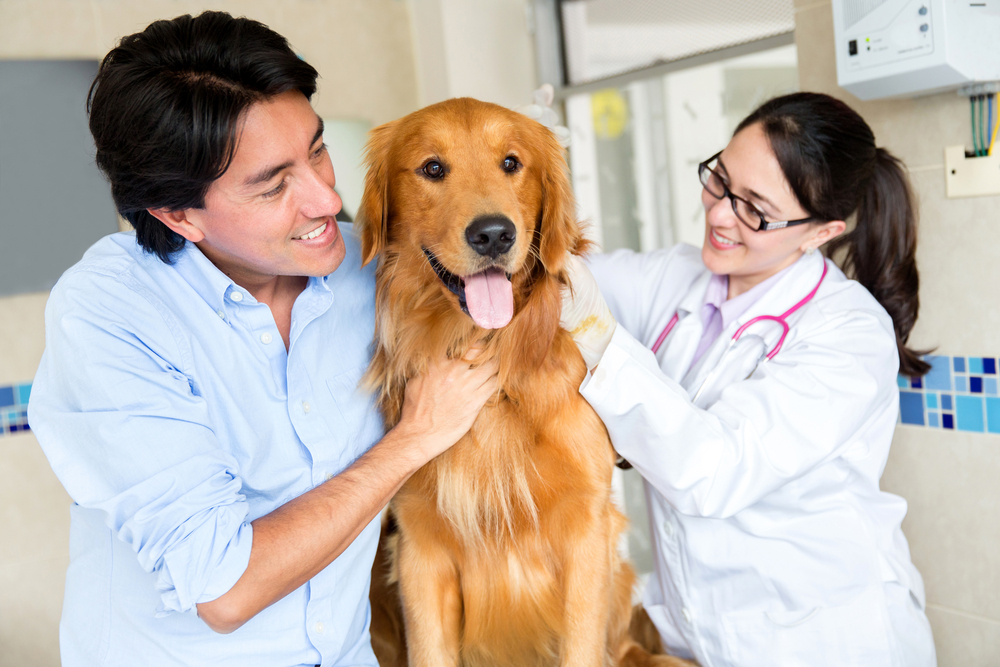If you’re anything like me, you probably hug your dog several times a day. It wasn’t until I became a veterinarian that I realized many dogs don’t like being hugged, and if they do, it’s not by strangers poking them with needles at the vet clinic. Many dogs are also uncomfortable with having areas of their body handled, such as their paws, ears, and mouth.
Unfortunately, when your dog gets examined by a veterinarian, they will often need to be hugged by a technician while we handle all of those areas and more. By doing some exam training at home, pet parents can help lower their dog’s fear, anxiety, and stress at the clinic.
The Up Side
Medium-size and large dogs are usually examined on the floor, but most vets examine small dogs on a counter or table. Since this isn’t a typical place for a dog to be, start by placing a non-slip dog bed on the floor and give a treat for going onto the bed. Next, place the bed on a slightly raised surface such as a coffee table and treat your dog for being on the table. Eventually you want your dog to be comfortable on a surface that’s waist-high to simulate an exam table. Always use pea-size, high-value treats and short training sessions over several days. Keep a hand on your dog at all times so they can’t jump off the table.
Getting Held
When you’re ready to start training for restraint, face your dog’s side. Hug their neck with one arm while your other arm hugs them over their back, then give a treat. Gradually build up the time during which your dog accepts being restrained, with the goal of two minutes of restraint.
Keep training sessions positive and end them before your dog starts squirming. If your dog shows any behaviors such as tensing, lifting their lip, or growling, stop immediately and talk to your vet or a Fear Free certified trainer.
Hands On
Once you’ve trained your dog to accept restraint, you’re ready to move on to training for an exam. There may seem like a lot of parts to an exam, but most dogs can be examined by a vet within a few minutes, especially if you’ve already done some training at home.
Using the same principles used for restraint, break down each area of handling into the multiple baby steps that comprise it. Keep treating and don’t move onto the next baby step unless your dog stays relaxed. If your dog has arthritis or another painful condition, avoid handling those areas. Training is important, but not at the expense of injuries or stressing your special bond.
If your dog is overall healthy, position yourself next to your dog while facing in the same direction. Practice the following, giving a treat after each repetition:
- Trailing your hand over the back and upper legs.
- Trailing your hand under their front legs from chest to abdomen.
- Touching the tail, then lifting it from the base.
- Lightly squeezing the spine with your fingers from shoulders to hips.
- Picking up one leg at a time underneath armpits or hips, then moving it forward and backward.
- Touching each paw, then lifting it.
- Very gently squeezing the abdomen from ribs to hips.
- Touching each ear, then lifting it (if floppy), then putting a finger gently into the ear to simulate an ear cone.
- Touching the lip, then lifting it.
- Holding the face while briefly making eye contact.
If you take the time to do exam training with your dog, not only will you teach them that being handled results in treats, but you’ll be able to identify areas of sensitivity that can be communicated to your vet. You may also find physical changes with your dog that warrant a vet visit, such as a new lump under the skin or a broken tooth. While your dog may still be a bit nervous when examined by your vet, any training you can do will go a long way toward achieving a Fear Free annual visit.
This article was reviewed/edited by board-certified veterinary behaviorist Dr. Kenneth Martin and/or veterinary technician specialist in behavior Debbie Martin, LVT.








